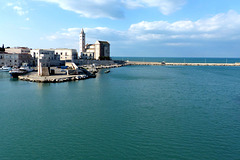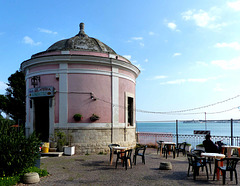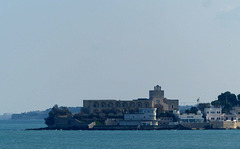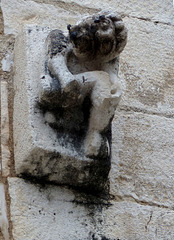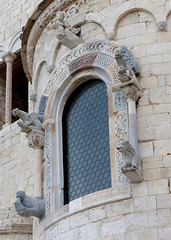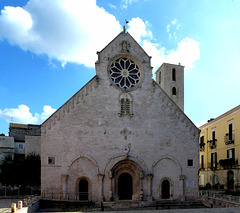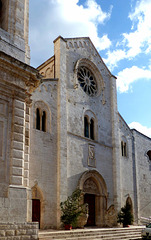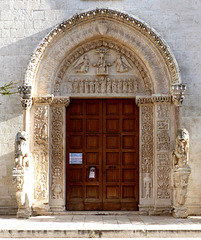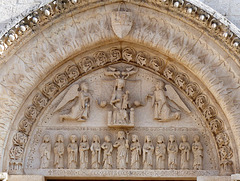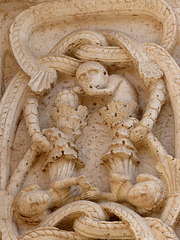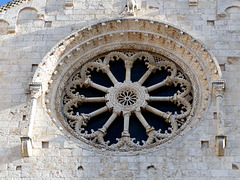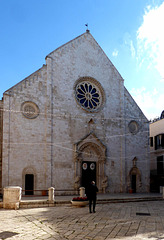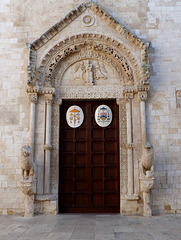
Puglia - Apulia - Apulien
Travelling slowly in Southern Italy.
Trani - San Nicola Pellegrino
| |
|
|
Trani may have been founded by Greek settlers, but the known history starts late. After the fall of the Roman Empire, it was dominated by Lombards, Byzantines, Saracens and again Byzantines. With the conquest of southern Italy by the Normans and after 50 days of siege by Robert Guiscard´s troops, Trani became part of the Norman Empire in 1073.
Already under the Byzantines, Trani had become an important port for trade with the Orient. The heyday was in the time of the crusades in the 12th and 13th centuries, when crusaders and merchants mainly went to the Holy Land from Bari and Trani. It became an episcopal see in place of Canosa, destroyed by the Saracens. Frederick II promoted the Teutonic Knights and the Jewish community and built a massive castle. Under his rule, the city reached its highest point of wealth and prosperity.
The construction of the "Cattedrale di Trani" began in 1099, over the earlier church of "Santa Maria della Scala", which went back to the 4th century.
It is dedicated to "San Nicola Pellegrino". Bari had the relics of "Saint Nicholas of Myra". The Bishop of Trani could convince Pope Urban II to canonized a young pilgrim, who had died on his way to Jerusalem in Trani in 1094 from exhaustion. The new church was intended to house the relics of "Saint Nicholas the Pilgrim".
Pina Belli d'Elia ("Puglia romanica") is sure, that this cathedral is the most important of all romanic buildings in Apulia.
The building process started at the crypt. The "translatio corporis S. Nicolai ad novam Ecclediam" took place in 1142. As parts of the old church, dedicated to Virgin Mary, were maintained, the construction is pretty complex. The "Cattedrale di Trani" was completed around 1200, the construction of the campanile started by Nicolaus Sacerdos (see "Bitonto") and completed in the mid 14th century. In the20th century the bell tower was in such a bad state, that it was completely dismantled and rebuilt in the 1950s to avoid it collapsing.
I have already uploaded many photos taken in Trani from previous visits. So I`ll try to cut the number down this time.
Trani - Castello Svevo
| |
|
|
Trani may have been founded by Greek settlers, but the known history starts late. After the fall of the Roman Empire, it was dominated by Lombards, Byzantines, Saracens and again Byzantines. With the conquest of southern Italy by the Normans and after 50 days of siege by Robert Guiscard´s troops, Trani became part of the Norman Empire in 1073.
Already under the Byzantines, Trani had become an important port for trade with the Orient. The heyday was in the time of the crusades in the 12th and 13th centuries, when crusaders and merchants mainly went to the Holy Land from Bari and Trani. It became an episcopal see in place of Canosa, destroyed by the Saracens. Frederick II promoted the Teutonic Knights and the Jewish community and built a massive castle. Under his rule, the city reached its highest point of wealth and prosperity.
Castello svevo (svevo = Swabian) was built from 1233 to 1247 during the reign of Emperor Frederick II. The castle was built on a rocky shore in the middle of the bay of Trani. A moat separated the castle from the mainland.
On one of the towers, Frederick II had Pietro Tiepolo, the son of the Venetian doge Jacopo Tiepolo. He had been captured as mayor of Milan at the Battle of Cortenova in 1237. Manfred of Sicily, the son of Frederick II, married his second wife here. After the end of the Hohenstaufen rule, which began with Manfred's death in the Battle of Benevento, the victorious House of Anjou rebuilt the castle so that in 1268 the marriage of Charles I of Naples and Margaret of Burgundy could be celebrated here. When the castle came under the rule of the Spanish under Charles V in 1533, it was extensively rebuilt to adapt it to the new defense requirements. The southern façade facing the countryside was reinforced and bastions were built on the corner towers.
From 1832 Castello Svevo was again rebuilt to transform it into a central provincial prison, which opened in 1844 and was in operation until 1974.
Trani - Bar Boschetto
| |
|
Trani may have been founded by Greek settlers, but the known history starts late. After the fall of the Roman Empire, it was dominated by Lombards, Byzantines, Saracens and again Byzantines. With the conquest of southern Italy by the Normans and after 50 days of siege by Robert Guiscard´s troops, Trani became part of the Norman Empire in 1073.
Already under the Byzantines, Trani had become an important port for trade with the Orient. The heyday was in the time of the crusades in the 12th and 13th centuries, when crusaders and merchants mainly went to the Holy Land from Bari and Trani. It became an episcopal see in place of Canosa, destroyed by the Saracens. Frederick II promoted the Teutonic Knights and the Jewish community and built a massive castle. Under his rule, the city reached its highest point of wealth and prosperity.
Bar Boschetto, housed in a circular pavilion in the city park, is a good place for espresso.
Trani - Santa Maria di Colonna
| |
|
|
Trani may have been founded by Greek settlers, but the known history starts late. After the fall of the Western Roman Empire, it was dominated by Lombards, Byzantines, Saracens and again Byzantines. With the conquest of southern Italy by the Normans and after 50 days of siege by Robert Guiscard´s troops, Trani became part of the Norman Empire in 1073.
Already under the Byzantines, Trani had become an important port for trade with the Orient. The heyday was in the time of the crusades in the 12th and 13th centuries, when crusaders and merchants mainly went to the Holy Land from Bari and Trani. It became an episcopal see in place of Canosa, destroyed by the Saracens. Frederick II built a massive castle. Under his rule, the city reached its highest point of wealth and prosperity.
The "Monastero di Santa Maria di Colonna" is located on a peninsula about two km south of Trani. According to tradition, the monastery was founded in the early 11th century by Norman Goffredo Siniscalco, The construction of the Romanesque church and the monastery buildings started probably in the first decade of the 12th century. Benedictine monks lived here, continuously attacked by Saracen pirates. In 1427 the Benedictines left the monastery and were succeeded by Franciscan monks. The Franciscans remained until 1867. It was used as a hospital for cholera patients and later was converted into military barracks. It soon fell into disrepair but meanwhile nicely renovated it is used for exhibitions and cultural events.
I have already uploaded many photos taken in Trani from previous visits. So I`ll try to cut the number down this time.
Trani - San Giacomo
| |
|
Trani may have been founded by Greek settlers, but the known history starts late. After the fall of the Western Roman Empire, it was dominated by Lombards, Byzantines, Saracens and again Byzantines. With the conquest of southern Italy by the Normans and after 50 days of siege by Robert Guiscard´s troops, Trani became part of the Norman Empire in 1073.
Already under the Byzantines, Trani had become an important port for trade with the Orient. The heyday was in the time of the crusades in the 12th and 13th centuries, when crusaders and merchants mainly went to the Holy Land from Bari and Trani. It became an episcopal see in place of Canosa, destroyed by the Saracens. Frederick II built a massive castle. Under his rule, the city reached its highest point of wealth and prosperity.
San Giacomo, in medieval times known as "Basilica of Santa Maria de Russis", was the first cathedral in Trani. It was built in the first half of the 12th century. Following the 1647 earthquake, the portal was put to the northern facade. Under the church is a small crypt, where once the tomb of San Nicola Pellegrino was placed before it was transferred to the "new" cathedral.
The church is adorned with three (!) elephants, you'll find them under photos I took previously. Here is a (damaged) spinario, trying to withdraw a thorn from the sole of his foot.
I have already uploaded many photos taken in Trani from previous visits. So I`ll try to cut the number down this time.
Trani - Chiesa di Ognissanti
| |
|
Trani may have been founded by Greek settlers, but the known history starts late. After the fall of the Western Roman Empire, it was dominated by Lombards, Byzantines, Saracens and again Byzantines. With the conquest of southern Italy by the Normans and after 50 days of siege by Robert Guiscard´s troops, Trani became part of the Norman Empire in 1073.
Already under the Byzantines, Trani had become an important port for trade with the Orient. The heyday was in the time of the crusades in the 12th and 13th centuries, when crusaders and merchants mainly went to the Holy Land from Bari and Trani. It became an episcopal see in place of Canosa, destroyed by the Saracens. Frederick II built a massive castle. Under his rule, the city reached its highest point of wealth and prosperity.
The "Chiesa di Ognissanti" (= All Saints) was probably founded in the 12th and completed in the 13th century. It is located next to the harbor, from where many crusaders sailed off to the Holy Land.
The tradition links the church to the Templar Order, but following the documents, it is more likely that it was the church of the merchant colony of Ravello. It may well have been a place of blessing for the crusaders.
The church became the property of the bishop of Conversano and in 1479 was donated to the Lambertini family, which originated from, Ravello.
Since the 19th century, the church is as well known as "Chiesa del Purgatorio". It became the seat of several Confraternities. It served the parish up to 1975 and became the seat of the Secular Franciscan Order in the 1980s. Now it seems to be the "Sito ufficiale dei Templari Cattolici d´Italia".
.
The apse window
Ruvo di Puglia - Concattedrale di Santa Maria Assu…
| |
|
|
The area was colonized between the 8th and 5th centuries BC by the Greeks. Around the 4th century BC the village conducted commercial exchanges with most of the Italic populations and minted its own currency. Ruvo established itself as a thriving polis of Magna Graecia.
After the end of the Hellenistic age in Apulia, the town played a role for the Roman Republic, first being assigned Roman citizenship, then the title of municipium and finally becoming the station of the Via Traiana.
In the 5th century, Ruvo disappeared under the blows of the invasions of the Goths which reduced the city to a pile of rubble. Ruvo, refounded on the slopes of the original hill, was first conquered by the Lombards and then fell prey to the Saracens. It was the people who decided then to equip themselves with a wall with towers. In the 11th century, Ruvo entered the county of Conversano and suffered violence due to internal struggles for power, which conflicts led to the second destruction of the town. However, it was under Frederick II that Ruvo finally recognized cultural and economic growth, a period marked by the construction of the Romanesque-Gothic cathedral.
Ruvo Cathedral was the episcopal seat of the Diocese of Ruvo, it is now a co-cathedral in the Diocese of Molfetta-Ruvo-Giovinazzo-Terlizzi. The building was built between the 12th and 13th centuries, with several later alterations.
The current exterior is the result of early 20th-century restoration works which removed all the Baroque additions. The church has a sloped façade with three portals. The central one, flanked by two columns standing on lions and surmounted by griffins, has internal reliefs which were once part of an earlier construction. The smaller ones, at the sides, have a simpler shape, with two semi-columns supporting ogival arches; they also belonged to previous buildings.
Ruvo di Puglia - Concattedrale di Santa Maria Assu…
| |
|
|
|
The area was colonized between the 8th and 5th centuries BC by the Greeks. Around the 4th century BC the village conducted commercial exchanges with most of the Italic populations and minted its own currency. Ruvo established itself as a thriving polis of Magna Graecia.
After the end of the Hellenistic age in Apulia, the town played a role for the Roman Republic, first being assigned Roman citizenship, then the title of municipium and finally becoming the station of the Via Traiana.
In the 5th century, Ruvo disappeared under the blows of the invasions of the Goths which reduced the city to a pile of rubble. Ruvo, refounded on the slopes of the original hill, was first conquered by the Lombards and then fell prey to the Saracens. It was the people who decided then to equip themselves with a wall with towers. In the 11th century, Ruvo entered the county of Conversano and suffered violence due to internal struggles for power, which conflicts led to the second destruction of the town. However, it was under Frederick II that Ruvo finally recognized cultural and economic growth, a period marked by the construction of the Romanesque-Gothic cathedral.
Ruvo Cathedral was the episcopal seat of the Diocese of Ruvo, it is now a co-cathedral in the Diocese of Molfetta-Ruvo-Giovinazzo-Terlizzi. The building was built between the 12th and 13th centuries, with several later alterations.
The current exterior is the result of early 20th-century restoration works which removed all the Baroque additions. The church has a sloped façade with three portals. The central one, flanked by two columns standing on lions and surmounted by griffins, has internal reliefs which were once part of an earlier construction. The smaller ones, at the sides, have a simpler shape, with two semi-columns supporting ogival arches; they also belonged to previous buildings.
The main portal
Bitonto - Duomo di Bitonto
| |
|
|
|
Bitonto, today a city of a population of about 55000, was probably founded by Greek settlers. Traces of a city wall dating to the 5th and 4th century BC were found. Later "Civitas Butuntinenses" became a self-governing Roman municipium,
During the 9th century, Bitonto successfully withstood a Saracen raid but got destroyed by Byzantine troops in 975. The Normans took over Apulia. In the 11th and 12th century. Under the rule of the Normans of Roger II of Sicily, William I of Sicily (aka William the Wicked) and William II of Sicily (aka William the Good), the city prospered and got new walls.
In 1227, Bitonto was the scene of the ex-communication of Frederick II accused by pope Gregory IX of having come to terms with sultan al-Malik al-Kamil.
-
The Bitonto Cathedral, dedicated to San Valentino, was erected 1175/1200 in the center of the city. The construction was probably influenced by the "Basilica of San Nicola" in Bari and was done in the typical "Apulian Romanesque" style. It is proven that the bishopric existed in 1089, though the crypt of the cathedral has remains of a 5th-century church.
I have taken lots of photos here on previous visits and will only upload a few now. Here you can find many more:
www.ipernity.com/doc/323415/album/1333170?view=0
Bitetto - San Michele Arcangelo
| |
|
|
After the fall of the Roman Empire and the defeat of the Goths and Lombards, Apulia was reconquered by the Byzantine Empire. A Byzantine monastery was founded to control the population, which suffered from a heavy tax burden.
After the expulsion of the Byzantines from Bari by Norman Roberto il Guiscardo in 1071 things changed. Bitetto was elevated to a bishopric and the archbishop received nearby Bitritto as a fief. The town was destroyed twice in 1164 by William the Wicked (Guglielmo il Malo) during the rebellion against his father Roger II.
The church served as the cathedral of the diocese of Bitetto , which existed until 1818.
The cathedral was built between 1026 and 1089, but the current appearance is due to a reconstruction in 1335, carried out by Master Lillo da Barletta. Further changes were made in the 16th century. These alterations required a new consecration so that in 1613 the cathedral, already consecrated in honor of Maria Assunta, was dedicated to the Archangel Michael.
Bitetto - San Michele Arcangelo
| |
|
|
After the fall of the Roman Empire and the defeat of the Goths and Lombards, Apulia was reconquered by the Byzantine Empire. A Byzantine monastery was founded to control the population, which suffered from a heavy tax burden.
After the expulsion of the Byzantines from Bari by Norman Roberto il Guiscardo in 1071 things changed. Bitetto was elevated to a bishopric and the archbishop received nearby Bitritto as a fief. The town was destroyed twice in 1164 by William the Wicked (Guglielmo il Malo) during the rebellion against his father Roger II.
The church served as the cathedral of the diocese of Bitetto , which existed until 1818.
The cathedral was built between 1026 and 1089, but the current appearance is due to a reconstruction in 1335, carried out by Master Lillo da Barletta. Further changes were made in the 16th century. These alterations required a new consecration so that in 1613 the cathedral, already consecrated in honor of Maria Assunta, was dedicated to the Archangel Michael.
The portal, flanked by two lions was created at different times. The tympanum is early Gothic and shows the Coronation of Mary above the apostles. It is dated and signed on the lintel (1335 Lillo da Barletta, The sides are Romanesque and date from before the reconstruction.
Bitetto - San Michele Arcangelo
| |
|
|
After the fall of the Roman Empire and the defeat of the Goths and Lombards, Apulia was reconquered by the Byzantine Empire. A Byzantine monastery was founded to control the population, which suffered from a heavy tax burden.
After the expulsion of the Byzantines from Bari by Norman Roberto il Guiscardo in 1071 things changed. Bitetto was elevated to a bishopric and the archbishop received nearby Bitritto as a fief. The town was destroyed twice in 1164 by William the Wicked (Guglielmo il Malo) during the rebellion against his father Roger II.
The church served as the cathedral of the diocese of Bitetto , which existed until 1818.
The cathedral was built between 1026 and 1089, but the current appearance is due to a reconstruction in 1335, carried out by Master Lillo da Barletta. Further changes were made in the 16th century. These alterations required a new consecration so that in 1613 the cathedral, already consecrated in honor of Maria Assunta, was dedicated to the Archangel Michael.
The early Gothic tympanum shows the coronation of Mary and below it, Christ flanked by the twelve apostles. The date "1335" is inscribed on the left and the name of the master "Lillo da Barletta" is on the right side of the lintel.
Bitetto - San Michele Arcangelo
| |
|
After the fall of the Roman Empire and the defeat of the Goths and Lombards, Apulia was reconquered by the Byzantine Empire. A Byzantine monastery was founded to control the population, which suffered from a heavy tax burden.
After the expulsion of the Byzantines from Bari by Norman Roberto il Guiscardo in 1071 things changed. Bitetto was elevated to a bishopric and the archbishop received nearby Bitritto as a fief. The town was destroyed twice in 1164 by William the Wicked (Guglielmo il Malo) during the rebellion against his father Roger II.
The church served as the cathedral of the diocese of Bitetto , which existed until 1818.
The cathedral was built between 1026 and 1089, but the current appearance is due to a reconstruction in 1335, carried out by Master Lillo da Barletta. Further changes were made in the 16th century. These alterations required a new consecration so that in 1613 the cathedral, already consecrated in honor of Maria Assunta, was dedicated to the Archangel Michael.
The portal has an early Gothic tympanum (prev upload) and older Romanesque sides, probably from the first construction. Here are four panels, the Annunciation, the Nativity, the Adoration of the Magi, and the Massacre of the Innocents.
Bitetto - San Michele Arcangelo
| |
|
|
After the fall of the Roman Empire and the defeat of the Goths and Lombards, Apulia was reconquered by the Byzantine Empire. A Byzantine monastery was founded to control the population, which suffered from a heavy tax burden.
After the expulsion of the Byzantines from Bari by Norman Roberto il Guiscardo in 1071 things changed. Bitetto was elevated to a bishopric and the archbishop received nearby Bitritto as a fief. The town was destroyed twice in 1164 by William the Wicked (Guglielmo il Malo) during the rebellion against his father Roger II.
The church served as the cathedral of the diocese of Bitetto , which existed until 1818.
The cathedral was built between 1026 and 1089, but the current appearance is due to a reconstruction in 1335, carried out by Master Lillo da Barletta. Further changes were made in the 16th century. These alterations required a new consecration so that in 1613 the cathedral, already consecrated in honor of Maria Assunta, was dedicated to the Archangel Michael.
The portal has an early Gothic tympanum (former upload) and older Romanesque sides, probably from the first construction. Two hybrid creatures of humans and plants. The monkey, which also sprouts out of a plant, sniffs the fruit. Nightmares in stone.
Bitetto - San Michele Arcangelo
| |
|
|
|
After the fall of the Roman Empire and the defeat of the Goths and Lombards, Apulia was reconquered by the Byzantine Empire. A Byzantine monastery was founded to control the population, which suffered from a heavy tax burden.
After the expulsion of the Byzantines from Bari by Norman Roberto il Guiscardo in 1071 things changed. Bitetto was elevated to a bishopric and the archbishop received nearby Bitritto as a fief. The town was destroyed twice in 1164 by William the Wicked (Guglielmo il Malo) during the rebellion against his father Roger II.
The church served as the cathedral of the diocese of Bitetto , which existed until 1818.
The cathedral was built between 1026 and 1089, but the current appearance is due to a reconstruction in 1335, carried out by Master Lillo da Barletta. Further changes were made in the 16th century. These alterations required a new consecration so that in 1613 the cathedral, already consecrated in honor of Maria Assunta, was dedicated to the Archangel Michael.
The rose window
Conversano - Cattedrale di Conversano
| |
|
|
|
A settlement named Norba existed in the early times. It was conquered by the Romans in 268 BC and seems to have been abandoned around the time of the Visigothic invasion of Italy around 410.
The town recovered and was a bishopric seat from the 7th century on. This new town gained importance under the name Conversano, when, in 1054, the Norman lord Geoffrey, assumed the title of "Count of Conversano". He turned Conversano into the capital of a large county. After the count's death in 1101, the county was inherited by his sons Robert and Alexander. Alexander got defeated in 1132 by Roger II of Sicily, and the county was assigned to Roger`s brother in law Robert I of Basseville.
The cathedral was built in the 11th and 12th centuries on the site of an old place of worship and an earlier church. In 1358-1379 it was rebuilt, keeping its original form, and additional sculptures were added, especially on the facade.
The gable facade is divided into three parts with pilasters, in the upper part, there is a twelve-light rose window from the 15th century. The middle of the three portals is richly decorated with sculptures and shows two figures of lions.
Conversano - Cattedrale di Conversano
| |
|
|
A settlement named Norba existed in the early times. It was conquered by the Romans in 268 BC and seems to have been abandoned around the time of the Visigothic invasion of Italy around 410.
The town recovered and was a bishopric seat from the 7th century on. This new town gained importance under the name Conversano, when, in 1054, the Norman lord Geoffrey, assumed the title of "Count of Conversano". He turned Conversano into the capital of a large county. After the count's death in 1101, the county was inherited by his sons Robert and Alexander. Alexander got defeated in 1132 by Roger II of Sicily, and the county was assigned to Roger`s brother in law Robert I of Basseville.
The cathedral was built in the 11th and 12th centuries on the site of an old place of worship and an earlier church. In 1358-1379 it was rebuilt, keeping its original form, and additional sculptures were added, especially on the facade.
The gable facade is divided into three parts with pilasters, in the upper part, there is a twelve-light rose window from the 15th century. The middle of the three portals is richly decorated with sculptures.
The portal
Conversano - Cattedrale di Conversano
| |
|
A settlement named Norba existed in the early times. It was conquered by the Romans in 268 BC and seems to have been abandoned around the time of the Visigothic invasion of Italy around 410.
The town recovered and was a bishopric seat from the 7th century on. This new town gained importance under the name Conversano, when, in 1054, the Norman lord Geoffrey, assumed the title of "Count of Conversano". He turned Conversano into the capital of a large county. After the count's death in 1101, the county was inherited by his sons Robert and Alexander. Alexander got defeated in 1132 by Roger II of Sicily, and the county was assigned to Roger`s brother in law Robert I of Basseville.
The cathedral was built in the 11th and 12th centuries on the site of an old place of worship and an earlier church. In 1358-1379 it was rebuilt, keeping its original form, and additional sculptures were added, especially on the facade.
The gable facade is divided into three parts with pilasters, in the upper part, there is a twelve-light rose window from the 15th century. The middle of the three portals is richly decorated with sculptures.
The late Romanesque tympanum shows Mary in the center and two angels wielding thuribles. Note the fantastic archivolts.
Jump to top
RSS feed- Latest items - Subscribe to the latest items added to this album
- ipernity © 2007-2024
- Help & Contact
|
Club news
|
About ipernity
|
History |
ipernity Club & Prices |
Guide of good conduct
Donate | Group guidelines | Privacy policy | Terms of use | Statutes | In memoria -
Facebook
Twitter

